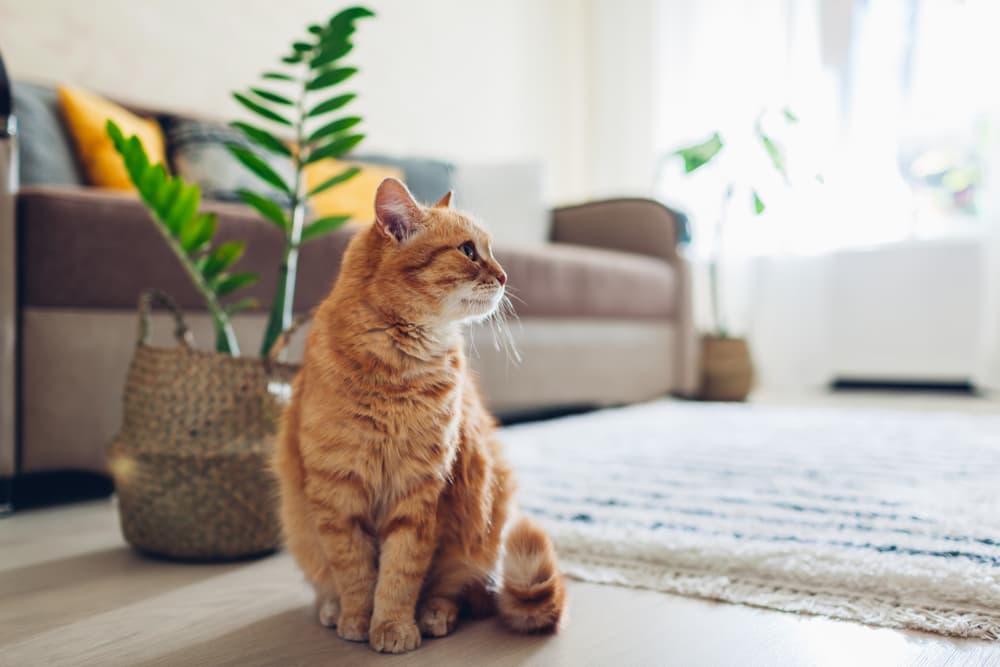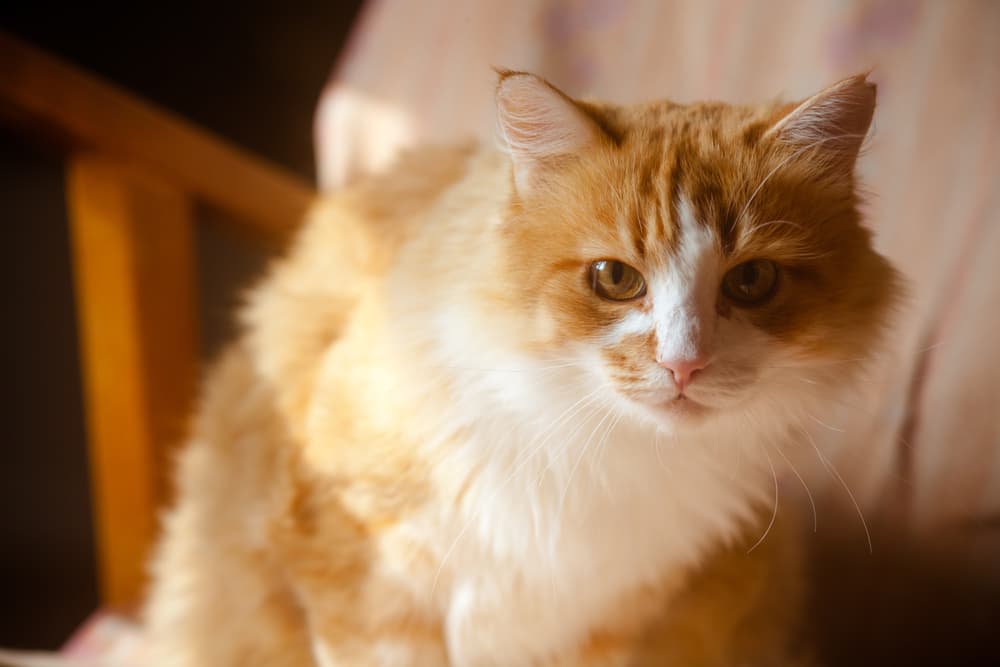Yellow Cat Poop: What Does It Mean?

Cat poop may not be the most glamorous topic, but it can provide you with important intel about your feline’s health. Consistency or color changes – including yellow cat poop – may be a sign of a potential problem that may require medical attention.
If your cat is pooping yellow, our guide may be able to answer your most pressing questions. Of course, only your veterinarian can offer a proper diagnosis.
Yellow Cat Poop: Deciphering Color and Consistency

Any yellow cat poop, whether it’s bright yellow cat poop, mustard-colored, or brownish-yellow, can indicate a potential health problem, veterinarians say. Color alone, however, doesn’t provide as much information as consistency does. Cat poop that is soft and yellow can mean something very different than cat poop that’s firm and yellow.
“If a cat is having yellow diarrhea, we would be more concerned with bacterial or parasitic infections,” says Amber LaRock, a licensed veterinary technician for Emergency Vets USA, with locations across the country. “If a cat is having firm, yellow stool, we may be more concerned with liver or autoimmune conditions.”
Softer or mucus-coated poop can also be a sign of digestive issues, says Dr. Cathy Lund, a veterinarian with City Kitty Veterinary Care for Cats in Providence, Rhode Island. “Or changes associated with intestine irritation caused by allergies or inflammatory bowel problems.”
Why It’s Important to Notice Changes in Cat Poop
Learning to identify changes in the color and consistency of cat poop isn’t anyone’s favorite pastime, but it serves an important purpose.
“Sometimes change in stool color or texture can be the first indicator, or sometimes the only indicator, of disease,” says Dr. Sasha Gibbons, an associate veterinarian at Just Cats Veterinary Hospital in Stamford, Connecticut. Therefore, it is very important to notify your veterinarian of any changes in stool color or consistency.
It can also aid in discussions you have with your veterinarian. “The appearance of a cat’s poop can’t offer us a concrete diagnosis, but it can certainly offer a few clues,” says LaRock.
Causes of Yellow Cat Poop

A cat pooping yellow may have an infection, a disease affecting an organ, or simply be reacting to a new diet – so it’s essential to touch base with your veterinarian. Though we can’t offer a diagnosis, we’ve outlined some of the most common causes of yellow poop in cats.
Digestive Issues
One common cause of a cat pooping yellow is digestive issues and poor nutrient absorption, veterinarians say. Here’s a look at some of what may be happening in your cat’s digestive tract.
The gallbladder secretes bile and bilirubin (which creates the yellow pigment) into the intestines, Lund explains. “Bile aids in the digestion of fats, and as it is metabolized, the fluid’s color changes from yellow-greenish to more brown,” she says. “If there isn’t a lot of bile getting secreted, or lots of fat in the diet, stool may be more yellowish in color because higher-fat diets typically move through the intestines much faster than is normal, and the stool doesn’t stay put long enough to turn that brownish color.”
Poor absorption of nutrients in the intestine from parasites, viral infections, bacterial infections, and inflammation is also a common cause of yellow cat poop, says Gibbons.
Liver and Gallbladder Issues
Cat poop that’s yellow and oily may be associated with liver problems or gallbladder blockages, says Lund. (The gallbladder is an organ within the liver.)
One of the most common types of liver disease in cats is caused by inflammation, which scientists theorize may be a result of bacteria traveling from the gastrointestinal system to the bile ducts, then permeating the gallbladder.
Cat diarrhea, weight loss, decreased appetite, and jaundice are some other signs associated with liver disease to watch for.
Chronic Pancreatitis (Inflamed Pancreas)
“In cats, chronic pancreatitis is another frequent reason for changes in the stool color since bile ducts can block, or the flow of bile can slow down with long-term disease,” says Lund.
Pancreatitis is the most common pancreatic disorder in cats and can be either acute or chronic. Signs of severe pancreatitis include abdominal pain, weight loss, vomiting, and jaundice. Pancreatitis can also cause cat poop to smell raunchy.
The Color of Foods Your Cat Has Eaten
Have you recently introduced your cat to a new diet or treat? A sudden and dramatic change in hue or consistency of your cat’s stool could simply be the result of a certain food your cat has just eaten, says Lund. “Classic causes are sweet potatoes and carrots, which some cats love to eat!”
What to Do if Your Cat is Pooping Yellow

“Changes in cat feces should be investigated if it persists or is accompanied by vomiting, not eating, and/or lethargy,” recommends Dr. Lisa Goin, a partner doctor with Heart + Paw in Glen Mills, Pennsylvania.
Depending on the cat’s age, medical history, and current symptoms, your veterinarian’s recommendations may vary, says Gibbons.
Here are some things you should consider and discuss with your veterinarian if your cat is pooping yellow:
Search for Important Clues
Doing some detective work can help your veterinarian form a diagnosis. LaRock recommends first determining if the poop is firm or soft. “If they are experiencing loose stool or diarrhea, we always suggest having them seen by a vet.”
If the poop is firm, LaRock says the next step is to answer the following: “Are there any changes in their appetite? Are there any changes in behavior? Have you changed their diet in the last week? Does the cat go outside? Are they over 10 years of age, and if so, have they had any blood work performed recently?”
With answers in hand, call your veterinarian, LaRock says. “If they are not concerned, they may offer you some guidance on home care.”
See if a Bland Diet Makes a Difference
If your cat appears fine and is eating normally, Lund suggests feeding a bland diet that’s lower in fats to see if it has any effect on color. “If they are consistent regardless of what is being fed, a veterinary exam is always a good idea.”
A bland diet may include a prescription diet designed for low-fat and GI symptoms that is recommended by your vet or an at-home diet of boiled chicken and rice. If the color and consistency of your cat’s poop does not improve after a few days of feeding a bland diet, talk to your veterinarian.
Cat Digestive Products to Consider

A variety of products and ingredients on the market are formulated to restore gut health, help reduce cat diarrhea, and lessen other symptoms.
One category of digestive products for cats is probiotics. “Probiotics are a wonderful way to inoculate the intestines with ‘good’ bacteria that aid in digestion,” says Lund. “They can be enormously useful in treating inflammatory bowel disease and chronic diarrhea.”
Though studies examining the benefits of probiotics for companion animals have been somewhat limited, those that have been performed show promise. One study found that shelter cats fed enterococcus faecium had fewer episodes of diarrhea than cats in the control group. Another study showed that Lactobacillus acidophilus seemed to improve the quality of poop in healthy adult cats by increasing the number of ‘good’ bacteria (lactobacilli) and decreasing the number of coliforms.
Another digestive supplement category to consider are gastrointestinal (GI) diets. “GI diets are also a great choice for easily-digestible, lower-fat diets in cats who have digestion issues,” says Lund.
Whichever product you do decide to use, we recommend reading the label carefully prior to use. And before giving your cat any supplement, check with a professional. “Probiotics and prescription diets formulated for diarrhea or constipation can be very helpful in controlling symptoms, but should be discussed first with a veterinarian,” says Goin.









